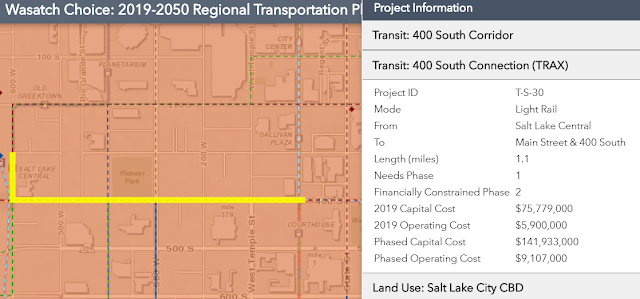I'm spending a lot of time reading about transit leverage/ transit land use multiplier right now. Just got done reading "How to Create Exponential Decline in Car Use in Australian Cities". Point made is that relying on increasing oil prices to drive transit ridership is only provides the 'push'. We need the 'pull' as well. And that means building a lot more transit.
I agree. I won't argue that we should build things like subways--they were built in a time where there was no alternative (excepting walking), so everyone was transit dependent (including the middle-class). Those times are not coming back--nor should we want them to. But it does mean the levels of demand that made heavy rail development profitable are not coming back. Sure, there are places that have been heavy-rail in the automobile era: DC, Atlanta, San Francisco, even a bit in Cleveland (1953). Even LA is doing it bit*.
To be effective, every transit station has to 'earn its keep' in terms of boardings and alightings (people getting on and off the train). That means there have to be enough people accessing the station. How people get to the station (walk, bike, bus, PnR) doesn't matter for this metric. Adding vehicles into the mix increases the 'range' a station can draw from.
What 'earn its keep' means is difficult. Does it need to cover operating costs? Maintenance? Initial investment/startup costs? If it's a market-lead initiative, then all three. However, valuing transportation infrastructure is difficult, because it's effectively permanent. Sure, there are construction costs, and upkeep costs, but obtaining a permanent 'easement' permitting a corridor is a one-time expense with a permanent benefit. Boston's subway tunnels have been operating since the 1880s's. 140 years and counting, with no end in sight. How to you value something like that?
I agree. I won't argue that we should build things like subways--they were built in a time where there was no alternative (excepting walking), so everyone was transit dependent (including the middle-class). Those times are not coming back--nor should we want them to. But it does mean the levels of demand that made heavy rail development profitable are not coming back. Sure, there are places that have been heavy-rail in the automobile era: DC, Atlanta, San Francisco, even a bit in Cleveland (1953). Even LA is doing it bit*.
To be effective, every transit station has to 'earn its keep' in terms of boardings and alightings (people getting on and off the train). That means there have to be enough people accessing the station. How people get to the station (walk, bike, bus, PnR) doesn't matter for this metric. Adding vehicles into the mix increases the 'range' a station can draw from.
What 'earn its keep' means is difficult. Does it need to cover operating costs? Maintenance? Initial investment/startup costs? If it's a market-lead initiative, then all three. However, valuing transportation infrastructure is difficult, because it's effectively permanent. Sure, there are construction costs, and upkeep costs, but obtaining a permanent 'easement' permitting a corridor is a one-time expense with a permanent benefit. Boston's subway tunnels have been operating since the 1880s's. 140 years and counting, with no end in sight. How to you value something like that?



